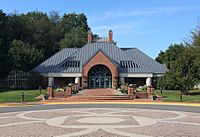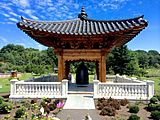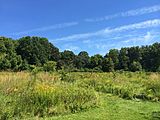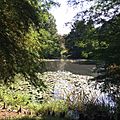Meadowlark Botanical Gardens facts for kids
Quick facts for kids Meadowlark Botanical Gardens |
|
|---|---|

Visitors Center at Meadowlark Gardens, Vienna, Virginia
|
|
| Lua error in Module:Location_map at line 420: attempt to index field 'wikibase' (a nil value). | |
| Type | Botanical garden |
| Location | 9750 Meadowlark Gardens Court Vienna, Virginia |
| Operated by | NOVA Parks |
Meadowlark Botanical Gardens is a beautiful place with over 100 acres of land. It's a special type of park called a botanical garden, located in Vienna, Virginia. People also use it for events like weddings.
You can visit the gardens every day, except on major holidays or when it's icy. There's a small fee to get in. If you want to take professional photos, you'll need to make a reservation and pay extra. NOVA Parks, an agency in Northern Virginia, takes care of and protects these gardens.
Contents
Discover the Gardens' Amazing Features
Meadowlark Botanical Gardens has many interesting areas to explore. One important building, called the Atrium, is often used for weddings and other special events. The gardens themselves are filled with natural beauty.
Water Features and Plant Collections
You'll find three peaceful ponds and two pretty gazebos. There's even a bridge connecting to an island! The gardens are home to more than twenty kinds of cherry trees, which look amazing when they bloom. You can also see many different water plants.
The gardens have special collections of plants, including:
- A colorful collection of azaleas.
- A quiet area with ferns and hostas.
- An herb garden with plants used for cooking or medicine.
- A fragrant lilac garden.
- Many different perennial flowers that come back year after year.
Native Plant Collections
Meadowlark Gardens also helps protect local plants. They have three special collections of plants that naturally grow in the area. This is part of a bigger plan called the International Agenda for Botanic Gardens in Conservation, which helps save plant species around the world.
- Potomac Valley Collection: This area features plants that are native to the Potomac River basin.
- Virginia Native Tree Collection: Here, you can see trees that grow naturally in Virginia and are good for home gardens. Examples include the pawpaw and the American hophornbeam.
- Virginia Native Wetland: This small wetland area has local trees like black birch and American sycamore. You'll also find aquatic plants such as water lilies and shoreline plants like cardinal flower.
Winter Walk of Lights
During the winter holidays, the gardens transform into a magical place. They put on a "Winter Walk of Lights" with thousands of Christmas-themed lights, music, and refreshments. It's a popular event for families.
Korean Bell Garden: A Symbol of Peace
One of the most unique parts of Meadowlark Gardens is the Korean Bell Garden. It's a special place that celebrates Korean culture and friendship.
The Bell of Peace and Harmony
The main feature is a huge bronze bell, called the Bell of Peace and Harmony. It weighs three tons and stands over seven feet tall! Large Korean bells have a long history, going back to the ancient Silla Dynasty.
The bell has beautiful engravings. You'll see Korea's national flower, the rose of Sharon, and Virginia's state flower, the dogwood. The words "Peace and Harmony" are also carved into the bell. Plus, there are ten traditional symbols of long life: the sun, mountain, water, cloud, stone, pine tree, white crane, turtle, mushroom of immortality, and deer.
The bell is housed in a wooden building called a pavilion. Korean craftspeople built this pavilion using traditional methods. They carved the wood so that each piece fits together without needing nails. The roof has upward-curving eaves and tiles made of a special clay called ocher.
History of the Korean Bell Garden
This Korean Bell Garden is very special because it's the first of its kind in the Western Hemisphere. The idea for it came from Jeung-Hwa Elmejjad-Yi, a woman who moved to the United States from Korea. She wanted to create a cultural landmark.
In 2005, she started the Korean American Cultural Committee to make her idea happen. By 2006, her group worked with the Northern Virginia Regional Park Authority to build the garden at Meadowlark. The whole project cost about $1 million. Most of the money came from donations by the Korean-American community in the Washington area, and the South Korean government also helped.
The groundbreaking ceremony, which is when construction officially begins, took place on June 27, 2010. This date was chosen because it was close to the 60th anniversary of the Korean War. Important people attended, including South Korean diplomats and U.S. politicians like Virginia Congressman Jim Moran and State Senator Chap Petersen. American and South Korean veterans were also there.
The pavilion was finished in the fall of 2010, and the huge bell arrived from Korea in May 2011. A special dedication ceremony for the bell was held on May 14. The official opening ceremony for the entire garden happened about a year later, on May 19, 2012. The Washington Korean Symphony Orchestra played music, including the American and Korean National Anthems. Korea's Ambassador at the time, Choi Young-jin, was also present.
Gallery
See also
 In Spanish: Jardín botánico Meadowlark para niños
In Spanish: Jardín botánico Meadowlark para niños








